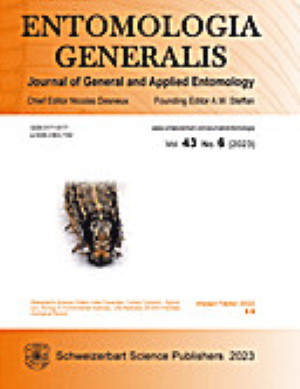Genetic diversity and genetic differentiation pattern of Tuta absoluta across China
IF 4.6
1区 农林科学
Q1 ENTOMOLOGY
引用次数: 0
Abstract
Tuta absoluta (Meyrick) is a cosmopolitan invader and one of the most serious pests of tomato. This pest has expanded rapidly in China since it initially invaded Xinjiang in the northwest in 2017 and Yunnan in the south in early 2018. More complete knowledge of the migration patterns and genetic structure of this pest is important for implementing effective management strategies. To fill this knowledge gap, the COI gene of T. absoluta was sequenced based on nationwide routine monitoring. This study showed a new invasion into Gansu and Inner Mongolia, indicating ongoing expansion of this pest. Most populations of T. absoluta, both in China and worldwide, have high genetic homogeneity. Nevertheless, some degree of genetic variability was found in populations in southern China, especially in Yunnan. Two distinct haplogroups were distinguished, and clade A was predominant at the global level. The high level of sequence divergence indicated the possible existence of cryptic species. Furthermore, FST and analysis of molecular variance (AMOVA) revealed weak but significant differentiation between the Xinjiang northwestern group and southern group/subgroups and provides compelling evidence of the different dispersal avenues of T. absoluta in northwestern and southern China. T. absoluta likely established bridgehead populations in Yunnan and then spread rapidly throughout this province and neighboring territories in southern China. Knowledge regarding genetic diversity, population structure and dispersal pattern is valuable for improving management guidelines for this pest. Strict plant quarantines, local eradication and practical control measures are needed to solve the problem caused by T. absoluta.中国绝种兔的遗传多样性及遗传分化模式
番茄巨蝽(Tuta absoluta, Meyrick饰)是一种世界性的入侵者,是番茄最严重的害虫之一。自2017年首次入侵西北部的新疆和2018年初入侵南部的云南以来,这种害虫在中国迅速蔓延。更全面地了解这种害虫的迁徙模式和遗传结构对实施有效的管理战略至关重要。为了填补这一知识空白,在全国常规监测的基础上对绝对T. COI基因进行了测序。在甘肃和内蒙古出现了新的入侵,表明该害虫正在扩大。在中国和世界范围内,绝大多数的绝棉居群具有高度的遗传同质性。然而,在中国南方,特别是云南的种群中发现了一定程度的遗传变异。两个不同的单倍群被区分出来,进化支A在全球水平上占主导地位。序列分化程度高,表明可能存在隐种。此外,FST和分子变异分析(AMOVA)显示新疆西北类群与南方类群/亚类群之间存在微弱但显著的差异,为中国西北和南方不同的分布途径提供了强有力的证据。绝色瓢虫可能在云南建立了桥头堡种群,然后迅速蔓延到该省和邻近的中国南部地区。关于遗传多样性、种群结构和扩散模式的知识对改进这种害虫的管理准则很有价值。严格的植物检疫、局部根除和切实可行的控制措施是解决该问题的必要措施。
本文章由计算机程序翻译,如有差异,请以英文原文为准。
求助全文
约1分钟内获得全文
求助全文
来源期刊

Entomologia Generalis
生物-昆虫学
CiteScore
7.10
自引率
18.80%
发文量
72
审稿时长
>12 weeks
期刊介绍:
Its scope covers all aspects of basic and applied research dealing with insects and more broadly with arthropods inhabiting wild, agricultural and/or urban habitats. The journal also considers research integrating various disciplines and issues within the broad field of entomology and ecology.
Entomologia Generalis publishes high quality research articles on advances in knowledge on the ecology and biology of arthropods, as well as on their importance for key ecosystems services, e.g. as biological control and pollination. The journal devotes special attention to contributions providing significant advances (i) on the fundamental knowledge and on sustainable control strategies of arthropod pests (including of stored products) and vectors of diseases, (ii) on the biology and ecology of beneficial arthropods, (iii) on the spread and impact of invasive pests, and (iv) on potential side effects of pest management methods.
Entomologia Generalis welcomes review articles on significant developments in the field of entomology. These are usually invited by the editorial board, but proposals may be sent to the Editor-in-Chief for preliminary assessment by the editorial board before formal submission to the journal. The journal also considers comments on papers published in Entomologia Generalis, as well as short notes on topics that are of broader interest.
 求助内容:
求助内容: 应助结果提醒方式:
应助结果提醒方式:


